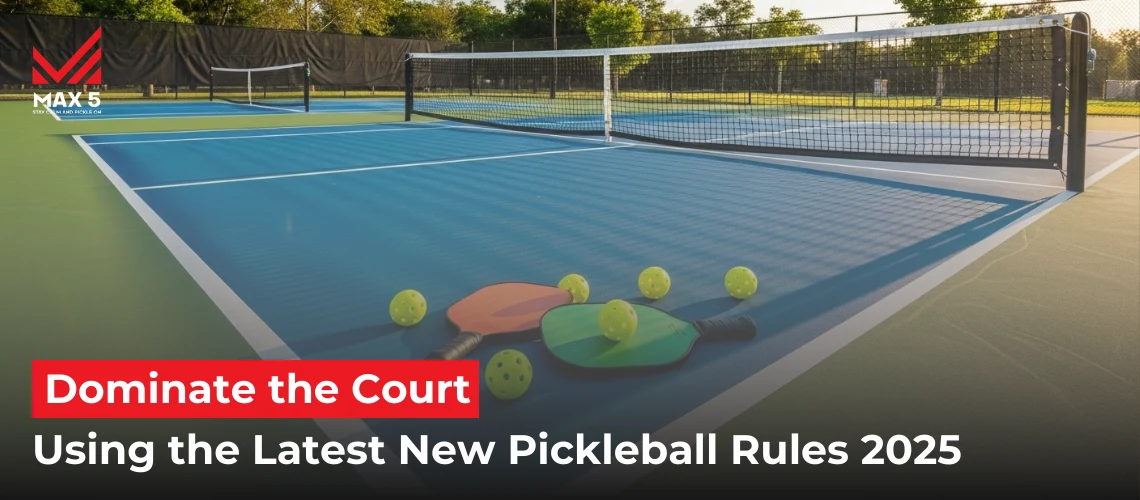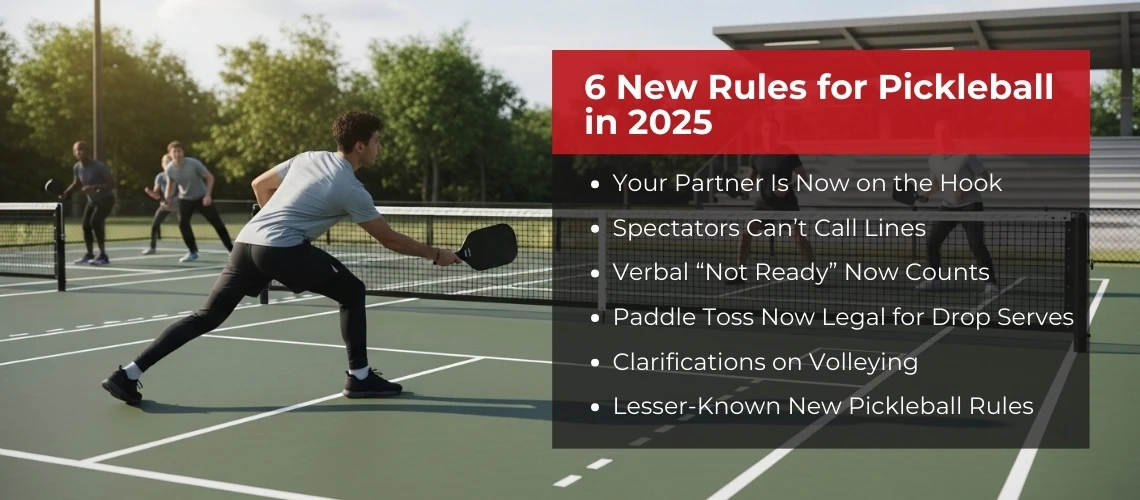
Dominate the Court Using the Latest New Pickleball Rules 2025
Pickleball is a combination of other sports, so it’s a well-known fact that the rules are never set; they change annually. New pickleball rules 2025 show that ongoing growth, refining gameplay through player feedback, rulebook clarity, and on-court fairness.
The 2025 pickleball rule changes are designed to influence the real play of both singles and doubles pickleball. Like, fault calls now extend to partners, verbal indicators like “stop” gain new recognition, and player contact during volleys is further clarified. This guide breaks down each change in detail and what it means for your game. There’s some good news for people who love customizing paddles, so stick around till the end!
6 New Rules for Pickleball in 2025
Each year, updates to the USA Pickleball rulebook improve gameplay and on-court fairness. In 2023, the spin serve was banned, apparel color rules were introduced, and referees gained the authority to replay uncertain serves. The “Am I Good?” rule helped simplify court positioning. By 2024, handling faults became stricter, carries or catches on the paddle became faults, and medical timeouts could be extended.
For 2025, the pickleball rule changes include rally scoring trials, volley contact clarifications, and stricter line call procedures. Every update in the 2025 pickleball rule book is based on feedback from experienced players who want the game to remain fast, fair, and accessible.
We’ll break down each of these new rules next, so you can return to the court confident and ready, whether you play after work, during class breaks, or between client calls. Here are the 5 new pickleball rules for 2025:
1. Your Partner Is Now on the Hook (Rule 13.D.1.a)
Now, players need to call a fault on their partner, just as they would on themselves, before the next serve is played. This applies to all types of faults, like foot faults, net contact, out balls, and violations in the non-volley zone.
Why it Changed:
Previously, partners weren’t obligated to call faults on each other, which created inconsistencies in tournament play. This update is more about maintaining fairness on the court and doesn’t change any gameplay.
Tournament Impact:
Tournament players must now act as a check on their team. If your partner steps on the kitchen line during a volley and you see it, you’re required to call it. Ignoring this rule could result in disputes or compromise your credibility in officiated events.
Rules 13.D.1.c and 7. O.
The rule now clarifies that a replay will only occur if there’s disagreement between teams, not just players. Additionally, Rule 7.O. was added to state that disagreements within a team benefit the opponents.
Why it changed:
The previous phrase, “any disagreement among players,” left room for confusion, which led to arguments between partners. The 2025 wording eliminates ambiguity: if teammates don’t agree on a call, the point goes to the other team.
Tournament impact:
This rule is especially relevant in close matches. Coordinated, honest fault calling within a team can preserve pace and avoid unnecessary replays. Just don’t expect a second chance if you and your partner aren’t aligned.
2. Spectators Can’t Call Lines (Rule 6.C.4)
Rule 6.C.4 now strictly prohibits players from soliciting or accepting input from spectators for line calls.
Why it changed:
Spectator interference, intentional or not, did create unnecessary confusion, especially in heated matches. The update is great for fairness over in-play decisions.
Tournament impact:
If someone in the stands calls a ball out and you respond to it, you risk losing the point. Officials will not entertain arguments based on outside opinions.
3. Verbal “Not Ready” Now Counts (Rule 4.C.2)
Players receiving a serve can now say “stop” or “wait” after the score is called to indicate they’re not ready. The server must then pause.
Why it changed:
Hand signals alone were often missed or ignored. The new verbal indicator rule offers a clear, audible method for players to signal unpreparedness, preventing rushed serves and preserving fair starts.
Tournament impact:
Tournament players can now use verbal indicators without penalty. However, overuse or abuse of this rule could lead to warnings. Use it when needed, but be ready to play within the flow of the match.
4. Paddle Toss Now Legal for Drop Serves (Rule 4.A.5)
The new pickleball drop serve rule change has players confused. But all it means is that players can now release the ball using either their hand or paddle, so long as gravity is the only force applied and no spin is imparted.
Why it changed:
This revision to the new pickleball serve rules acknowledges how players naturally develop unique serving habits. By allowing the paddle as a legal release method, the rule accommodates more flexible mechanics while keeping things fair by banning spin.
Tournament impact:
If you’re experimenting with drop serves in competitive play, you can now release the ball off your paddle face, just don’t spin it. Officials will monitor closely for manipulation during release, especially in advanced divisions.
5. Clarifications on Volleying (Rules 9.B.1 and 9.H)
Rule 9.B.1 defines a volley as starting when the ball is struck and ending when momentum stops. Rule 9. H prohibits players from contacting their partner or anything they’re carrying during a volley.
Why it changed:
The original definition created gray areas about when a player’s motion ended. This differentiates between legal momentum and faults stemming from extended movement or contact.
Tournament impact:
Pickleball players who volley near the kitchen should make sure not to brush against their partner while inside the NVZ. That’s now fault. Competitive players must be more mindful of spacing and court awareness during aggressive net play.
6. Lesser-Known New Pickleball Rules
Here are 3 new pickleball rules that are new but not talked about enough!
Rally Scoring Is Now Optional (Provisional Rules 4.G.1 and 12.B.1)
The 2025 pickleball rule book introduces rally scoring as a provisional option for doubles, mirroring what’s already allowed in singles.
Why it changed:
As pickleball grows globally, shorter match formats are gaining popularity. Rally scoring speeds up play and appeals to recreational and TV-friendly formats.
Tournament Impact:
Side-out scoring remains standard in major tournaments, but rally scoring may be adopted in certain brackets or formats. Make sure to clarify scoring systems with officials before your match begins.
Now that you’ve learned all the rules, it’s time to step onto the court and play. But before you dive in, it’s important to understand how to improve your performance and strategy. To help you get better at pickleball, be sure to read this guide.
Server Positioning Language Clarified (Rule 3.A.38)
The definition of “server” has been updated to clarify that the correct server is determined by the team’s score and original starting positions.
Why it Changed:
The prior wording was confusing, especially in rotation-heavy doubles play. This change simplifies interpretation and supports cleaner officiating.
Tournament Impact:
Misunderstanding server order can cost points. Knowing your exact position based on score and starting alignment is essential at the tournament level.
Equipment and Apparel Updates
• Smooth Paddle Surfaces Only:
All paddles must be free of any enhancements designed to increase spin. Textured or altered faces will not pass inspection. Try Max5’s latest Paddle to understand the feel of that. Moreover, you can use the Max5 pickleball paddle eraser for smoothing your paddle.
• Autographed Paddles Now Allowed (Rule 2.E.5.c):
Autographs are permitted on paddle surfaces, provided they don’t affect performance or texture.
• Apparel Color Restrictions (Rule 2.G.1):
Players must avoid clothing that matches the color of the ball for visibility reasons.
• One Paddle Rule (Appendix 8):
A guiding principle has been added to prevent any single paddle or type of play from dominating the sport. The focus is on preserving balance and the spirit of competition.
Tournament impact:
Before playing in sanctioned events, review your paddle and apparel choices. Something as small as a neon shirt or surface-marked paddle could disqualify you. Stick to approved paddles, like the Vintage MX-01 Carbon Pickleball Paddle, built for performance and compliant with 2025 guidelines.
What This All Means for 2025
The new pickleball rules 2025 are official updates based on “conflicts” that show up mid-rally, mid-argument, or mid-serve. All of the new rules will make sense to pickleball players of all skill levels. Calling faults on your partner, not taking cues from the crowd, verbal “not ready” calls- these are small shifts, but they change how the game flows.
We’ve noticed that with these new rules, beginners will get clarity, and tournaments will be more consistent. It’s still the game you know, just cleaner, faster, and a bit more strategic. Grab some friends, hit the court, try the new stuff, and if you’re overdue for a paddle upgrade, the Vintage MX-01 Carbon is tournament-legal and built to handle everything 2025 throws your way.
Frequently Asked Questions
What is the “2 becomes 1” rule in pickleball?
Play with respect. Call lines honestly, support your partner, and don’t take things too seriously. A good match feels fair, even if it’s competitive.
Can you put a spin on the serve in pickleball?
Play with respect. Call lines honestly, support your partner, and don’t take things too seriously. A good match feels fair, even if it’s competitive.
Can you hit the ball twice in one swing in pickleball?
Play with respect. Call lines honestly, support your partner, and don’t take things too seriously. A good match feels fair, even if it’s competitive.
What is the new targeting rule in pickleball?
Play with respect. Call lines honestly, support your partner, and don’t take things too seriously. A good match feels fair, even if it’s competitive.
What is the new headshot rule in pickleball?
Play with respect. Call lines honestly, support your partner, and don’t take things too seriously. A good match feels fair, even if it’s competitive.
How does pickleball support players with disabilities?
New rules allow reasonable adaptations. Wheelchair users can touch the kitchen and take two bounces. Everyone can now compete fairly

